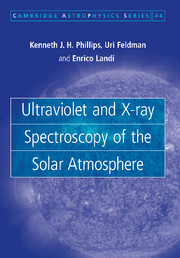Book contents
- Frontmatter
- Contents
- Preface
- 1 The solar atmosphere
- 2 Fundamentals of solar radiation
- 3 Fundamentals of atomic physics
- 4 Mechanisms of formation of the solar spectrum
- 5 Plasma diagnostic techniques
- 6 Ultraviolet and X-ray emission lines
- 7 Spectrometers and imagers for observing the solar ultraviolet and X-ray spectrum
- 8 Quiet Sun and coronal holes
- 9 Active regions
- 10 Solar flares
- 11 Element abundances
- Appendix 1 Units
- Appendix 2 Line lists
- Glossary
- Further reading
- References
- Index
8 - Quiet Sun and coronal holes
Published online by Cambridge University Press: 07 December 2009
- Frontmatter
- Contents
- Preface
- 1 The solar atmosphere
- 2 Fundamentals of solar radiation
- 3 Fundamentals of atomic physics
- 4 Mechanisms of formation of the solar spectrum
- 5 Plasma diagnostic techniques
- 6 Ultraviolet and X-ray emission lines
- 7 Spectrometers and imagers for observing the solar ultraviolet and X-ray spectrum
- 8 Quiet Sun and coronal holes
- 9 Active regions
- 10 Solar flares
- 11 Element abundances
- Appendix 1 Units
- Appendix 2 Line lists
- Glossary
- Further reading
- References
- Index
Summary
Introduction
Studies of the properties of the solar atmosphere began with the onset of space-borne instruments working in X-rays and the ultraviolet. The first instruments had poor spatial resolution and conclusions regarding the structure were indirectly inferred from spectroscopic observations. Early ultraviolet spectrometers also had poor spectral resolution, from which the intensities of the stronger lines could give only a general idea of the distribution of emission measure with temperature (Pottasch (1964)). With assumptions of plane parallel geometry and hydrostatic equilibrium, and with neglect of any fine structure possibly present (i.e. filling factors of unity), the gross features of the solar atmosphere could be deduced. From this, various models (Athay (1976), Mariska (1992)) indicated the presence of a narrow transition region, height range less than 100 km, between the chromosphere and corona. Figure 1.1 shows the atmospheric structure according to theoretical models. A growing corpus of observations, particularly those starting from the Skylab mission, showed that the transition region had a much larger extent than was indicated in earlier models, leading to a revision of our ideas of its nature, which are discussed in this chapter.
Bray et al. (1991) state in their book that ‘coronal loops are a phenomenon of active regions and there is growing evidence that they are the dominant structure in the higher levels (inner corona) of the Sun's atmosphere’. Indeed, the existence of large-scale coronal structures in quiet Sun regions was well known from white-light images during total solar eclipses for many years. They are observed to consist of large loops tapering to cusp-like apices beyond which are the coronal streamers.
- Type
- Chapter
- Information
- Ultraviolet and X-ray Spectroscopy of the Solar Atmosphere , pp. 210 - 230Publisher: Cambridge University PressPrint publication year: 2008

